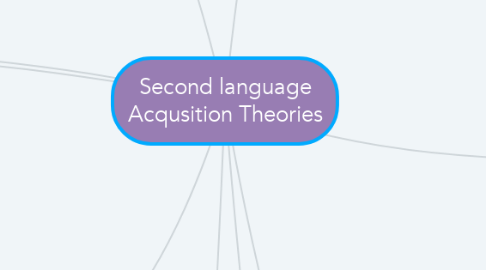
1. Five main hypothesis
1.1. The Monitor System
1.1.1. It explains the relation between acquisiton and learning
1.1.2. Learner´s learned system acts as a monitor
1.1.3. Editing and correcting
1.1.4. Learners
1.1.4.1. Over-users
1.1.4.1.1. Use the monitor all the time
1.1.4.2. Under-users
1.1.4.2.1. Extrover personality
1.1.4.3. Optimal -users
1.1.4.3.1. Use monitor appropriately
1.2. The Natural Order Hypothesis
1.2.1. Some structures tend to be acquired early while others late
1.3. The Input Hypothesis
1.3.1. Learners receive messages they can understand
1.4. Affective Filter Hypothesis
1.4.1. Affective variables
1.4.1.1. Facilitate the SLA
2. Behaviourism
2.1. proposed by
2.1.1. J.B. Watson
2.1.1.1. focus
2.1.1.1.1. observable behaviours which are changed as the symptoms of learning. According to Brown (1987: 17)
2.2. Classical conditioning
2.2.1. Pavlov
2.2.1.1. the original stimulus and paired with a neutral conditional stimulus repeatedly giving rise to the desired reaction.
2.3. Watson´s conditioning theory
2.3.1. learning is a process of interaction between stimulus and response
2.4. Thorndike's Theory of Connectivism
2.4.1. Law of rediness
2.4.1.1. The organism will learn only when he is physically and mentally ready for it.
2.4.2. Law of exercise
2.4.2.1. Drill and practice increase efficiency and durability of learning.
2.4.3. Law of effect
2.4.3.1. The relationship tends to be reinforced if the stimulus response and tend to be weakened as a result pleasant if the result is not satisfactory
3. Krashen´s theories
4. Cognitive development perspectives
4.1. Seek to explain the dynamic process
4.1.1. Human minds grow
4.2. Cognition
4.2.1. o
4.2.1.1. capabilities
4.2.1.1.1. memory, thinking, reasoning,spatial processing, problem solving,language and perception
4.3. Piaget and constructivism
4.3.1. Four stages
4.3.1.1. Sensorimotor
4.3.1.2. Preoperational
4.3.1.3. Concrete intellectual operations
4.3.1.4. Formal operations
5. Acculturation Theory
5.1. Schumann
5.2. focuses
5.2.1. Sociocultural factors
5.2.2. Its influence on language
5.2.3. Acquiring a new language
5.3. Promotes
5.3.1. Merging and understanding of cultures
5.4. Social distance
5.4.1. Dominance/subordination
5.4.1.1. Status of a group in relation to another.
5.4.2. Integration pattern
5.4.2.1. Less integration between two cultures=greater social distance
5.4.2.2. More integration= less social distance
5.4.3. Degree of enclousure of both groups
5.4.3.1. The two groups share the same social facilities (low enclousure) or have different social facilities (high enclousure)
5.4.4. Cohesiveness states
5.4.4.1. Cohesive Tight-knit group of learners=more social distance
5.4.4.2. Non-cohesive, learner group less united= less social distance
6. Innatist Cognitive Approaches
6.1. Noam Chomsky
6.1.1. Everyone is born with a common set of rules.
6.1.2. There is a template for learning a first language
6.1.3. The Lnguage Acquisition device
6.1.3.1. children are born with a special ability to process language
6.1.3.1.1. innate Language Acquisition Device
6.1.3.1.2. Innatist model
6.1.4. Universal Grammar
6.1.4.1. Language= autonomous faculty separate from intelligence.
7. Vygotsky theory
7.1. Sociocultural theory
7.1.1. Fundamental role of social interaction in the development of cognition.
7.1.2. In Second language
7.1.2.1. Second language learners advance
7.1.2.1.1. interact with more knowledgeable speakers of SL
7.2. Internal system of meaning
7.2.1. Internal structure of sign operation
7.3. Three stages of language
7.3.1. Pre intellectual social speech
7.3.2. Egocentric speech
7.3.3. Inner speech
7.4. Constructivism
7.4.1. The students construct their view of the world.
7.4.1.1. Internalizing concepts through self-discovery
8. Saphir-Whorf Theory
8.1. Linguistic Relativity
8.1.1. Claims that the structure of a language affects its speakers' world view or cognition, and thus people's perceptions are relative to their spoken language.
8.1.2. Strong Hypothesis
8.1.2.1. language determines thought and that linguistic categories limit and determine cognitive categories.
8.1.3. Week hypothesis
8.1.3.1. Linguistic categories and usage only influence thought and decisions.
8.1.4. Language and thought
8.1.4.1. Lingualism
8.1.4.1.1. There is no thought without language.
8.1.4.1.2. Denies the intelligibility of any kind of thought whatsoever in the absence of language.
8.1.4.2. Language of though
8.1.4.2.1. Believe that public language is inessential to private thought.
8.1.4.2.2. Thoughts are "sentences in the head

